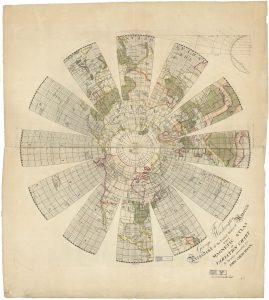By Heather Rockwood, Communications Manager
In 1780–1784, John Adams was in Amsterdam negotiating loans from the Dutch Republic so that the United States could be more independent from France. On 1 June 1783, Adams wrote in his diary what he knew about lodestones, and what experiments he thought scientists should do to learn more about them.
“The Loadstone is in Possession of the most remarkable, wonderfull and misterious Property in Nature. This Substance is in the Secret of the whole Globe. It must have a Sympathy with the whole Globe. It is governed by a Law and influenced by some active Principle that pervades and operates from Pole to pole, and from the Surface to the Center and the Antipodes. It is found in all Parts of the Earth. Break the Stone to Pieces, and each Morcel retains two Poles, a north and a south Pole, and does not loose its Virtue. The Magnetic Effluvia are too subtle, to be seen by a Microscope, yet they have great Activity and Strength. Iron has a Sympathy with Magnatism and Electricity, which should be examined by every Experiment, which Ingenuity can devise.
Has it been tryed whether the Magnet looses any of its Force in Vacuo? in a Bottle charged with Electrical Fire? &c. This Metal called Iron may one day reveal the Secrets of Nature. The primary Springs of Nature may be too subtle for all our Senses and Faculties. I should think however that no Subject deserved more the Attention of Philosophers or was more proper for Experiments than the Sympathy between Iron and the magnetical and Electrical Fluid.
It would be worth while to grind the Magnet to Powder and see if the Dust still retained the Virtue. Steep the Stone or the Dust in Wine, Spirits, Oyl and other fluids to see if the Virtue is affected, increased or diminished.
Is there no Chimical Proscess, that can be formed upon the Stone or the Dust to discover, what it is that the magnetic Virtue resides in.
Whether boiling or burning the Stone destroys or diminishes the Virtue.
See whether Earth, Air, Water or Fire any wise applied affects it, and how.”
Diary of John Adams, vol. 3, 1 June 1783
A lodestone is a type of rock found naturally magnetized and usually near the earth’s surface. The current theory (pun intended) is that the stone, called magnetite or Fe₃0₄, is not magnetized by the poles of the earth, which would be too weak to magnetize rock so far from them, but by magnetic fields surrounding lightning bolts. The lodestone had been used for more than a millennium for seafaring navigation because of its property to point towards the north and south poles anywhere on the globe, and because of its availability in North and South America and Europe.
Searching the internet to see if anyone has performed the tasks suggested by Adams on a lodestone, I came up with the following items: an article that confirms “garlic breath” has no effect on lodestones; a book published in 1600, De Magnete by William Gilbert (1544?–1603); and a letter written byPetrus Peregrinus The Magnet (1269). All these sources discuss experiments conducted on lodestones.
In 1787, while John Adams served as the first U.S. ambassador to Great Britain, he received a letter from Pelatiah Webster (1726–1795), dated 7 June 1787. Webster’s letter recommended Mr. John Churchman of Philadelphia, Penn., who had discovered a way to decipher the longitude of any place on the earth on any day using a magnetized lodestone. (Latitude lines are the same distance from each other and therefore easier to determine than longitude lines, which grow closer together as they reach the poles.) This excerpt is from Webster’s letter:
“Viz that the Magnectic needle has two poles one 13.°56′ from the N. Pole of the Earth the other South, abt. 18.o from the S. Pole of the Earth, Which Poles have a Constant Rotation from West to East, & form their Revolutions in 463 Years, & 344 days i.e. abt. 47′ Minutes of a degree in a Year, that the True place of these poles may be Ascertain’d, & Tables of the Same calculated for Every Given Minute of Time, & of Course that the line or point of no Variation for Any place & the Time, may be Easily found, & of Course the Angle of Variation & Radius will always be Attainable, & the Difference of Latitude of the place of observation & that of the Magnetic Pole will be one Side of the Triangle Necessary to be found.”
Churchman also corresponded with Thomas Jefferson and wrote this letter on 6 June 1787, transcribing his pamphlet and explaining his theory a bit more.
From Churchman’s research he created this map:

The way to decipher longitude had not been discovered by 1714 when Great Britain’s Parliament created a large monetary prize for the person who presents the solution to the newly formed Board of Longitude. Churchman took his theory to the board for 17 years from 1787 to 1804, convinced he had the solution; however, the Board never approved it. See their record of correspondence with Churchman’s many letters. He also applied to the American Philosophical Society for recognition of his theory in 1787, where it was also declined.

